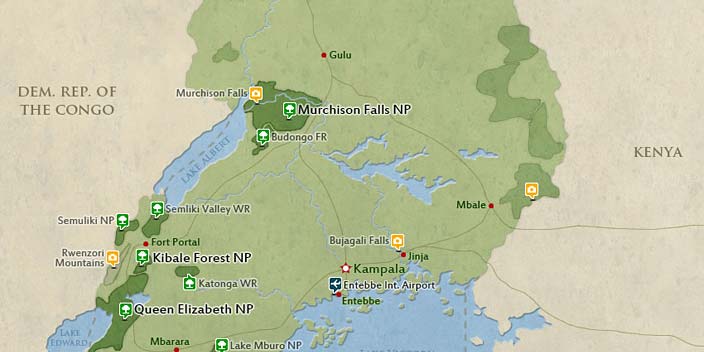
Arrival
Arrival

Day 1
To Rwenzori Mountains
To Rwenzori Mountains
After an early morning breakfast, you will set off for Kasese through Fort Portal in southwestern Uganda. It is a very beautiful drive with a lot of exciting things to see along the way. These include the people, food markets, forests and the large tea estates. You will stop in Fort Portal for lunch after which we shall head to Kasese for the night. You will be briefed by your guide about the trek beforehand.
- Main Destination:
- Rwenzori Mountains (Mountain Range)
- Accommodation:
- Rwenzori Trekkers Hostel
- Meals & Drinks:

Day 2
Stage 1: Sine Hut (2585 m)
Stage 1: Sine Hut (2585 m)
After spending the night in the hotel, which is actually considered the camp base, you will begin your trek by going to the UWA Park Headquarters in the morning. At the gate, you will be briefed by the rangers on the rules of the national park. We will then start by walking up the valley floor through an Afro Montane Forest Zone. This is a steady climb with a chance of seeing different types of primates and forest birds. There is a wide variety of plant species from forest trees to bamboo thickets, low shrubs, flowers, and fungi. Many moss and lichen-covered vines hang from the tall trees, creating an awesome appeal. Before reaching Sine Hut, the arrival point of the day at 2.585 m altitude, you stop over at Enock’s Falls, a beautiful scene. You will be served dinner and spend the night.
- Main Destination:
- Rwenzori Mountains (Mountain Range)
- Accommodation:
- Sine Hut
- Meals & Drinks:

Day 3
Stage 2: From Sine Hut to Kalalama Camp (3147 m) to Mutinda Camp
Stage 2: From Sine Hut to Kalalama Camp (3147 m) to Mutinda Camp
After breakfast, the trekking starts at 8.30 am. You soon enter the bamboo-mimulopsis zone, which is a steep climb with many high steps. After about 1.8 km, you reach Kalalama Camp (3,147 m), which is located in the heather–rapanea zone. Here you will have a rest and a cup of tea.
From this point, you proceed along the heather zone, passing by several streams and even waterfalls, all covered by the typical green moss vegetation. You will see a lot of giant heather trees, sometimes in a misty atmosphere. The arrival point of the day is Mutinda Camp, at 3,688 m, named after the Mutinda Peaks. The camp is set near a small river that drops off a waterfall and offers a chance to refresh and relax. You may wish to climb up to the top of the Mutinda Lookout (1hr 30min up and 1hr down). The view and the atmosphere are amazing as you stand on moss-covered rocks at 3,925 m with views across the Rwenzori Mountains, down to Kasese town and Lake George.
- Main Destination:
- Rwenzori Mountains (Mountain Range)
- Accommodation:
- Mutinda Camp
- Meals & Drinks:

Day 4
Stage 3: From Mutinda Camp to Bugata Camp (4062 m)
Stage 3: From Mutinda Camp to Bugata Camp (4062 m)
The trail from Mutinda Camp is a bit boggy, with the typical wet vegetation and tussocks. You will enter the alpine vegetation zone, with the presence of the giant lobelias (Lobellia gibberoa), the groundsel (Senecio adnivalis) and the everlasting flowers as you cross the Mutinda Valley. You later climb a steep section up to Namusangi Valley (3,840 m), from where you will enjoy the best view of the Mutinda Peaks. Along the Namusangi Valley, you cross various bogs as you climb to Bugata Camp at 4,062 m, the arrival point of the day. You will have a view of the Weisman’s Peak of Mount Luigi of Savoy, often covered by the snow. The vegetation area is covered with tussock grass, everlasting flowers, giant groundsel and giant lobelia. From the nearby Plozza Rock, you will get fantastic views of nine lakes down the valley and Lake Nusuranja. Bugata Camp has good facilities, solar lights, good toilets and bathrooms where the guides may prepare some warm water in a basin for you to wash.
- Main Destination:
- Rwenzori Mountains (Mountain Range)
- Accommodation:
- Bugata Camp
- Meals & Drinks:

Day 5
Stage 4: From Bugata Camp to Butawu Camp (3978 m)
Stage 4: From Bugata Camp to Butawu Camp (3978 m)
Starting at 4,062 m, the walk is 6.2 km, climbing over 4,450 m and sleeping at 3,974 m. Trekking starts at 8.30 am upwards to Bamwanjara Pass. The trail climbs steadily with several long flat bogs. The area is covered with everlasting flowers and giant groundsel with the bogs being mainly tussock grass, and giant lobelia whose nectar is the main food source for the Scarlet-tufted malachite sunbird (Nectarinia johnstonu dartmouthi) which is common in this area and unique to the Rwenzori Mountains. From the Banwamjara Pass, you get excellent views of all the main snow-capped peaks where we have a small shelter for you to rest and enjoy the scenery. The walk down to Kacholpe Lakes is steep and often very muddy, but offers fantastic views of Kachope Lakes and McConnell’s Prong. Butawu Camp (3,974 m) is set on a ridge high above Butawu River which flows down from Scott Elliott Pass through Kitandara Lakes and has excellent views of the snow-capped Mt Baker. Overnight at Butawu Camp.
- Main Destination:
- Rwenzori Mountains (Mountain Range)
- Accommodation:
- Hunwick's Camp
- Meals & Drinks:

Day 6
Stage 5: From Butawu Camp to Margherita Camp (4485 m)
Stage 5: From Butawu Camp to Margherita Camp (4485 m)
Walk back along the ridge before crossing several wet areas and small rivers coming from Mt Baker and Freshfields Pass to join Butawu River. The walk up Scott Elliott Pass is enjoyable as you climb through the pass and up the ridge of Mt Stanley to Margherita Camp at 4,485 m which is below Elena Hut. It is sheltered with a ring of high rocks and it is the original camp used by the Italian Prince Luigi Amadeo di Savoia, Duke of the Abruzzi. From here you have great views of Mt Baker, the Scott Elliot Pass and some of the high glaciers on Mt Stanley. Note: The day's hike is 4.2 km.
- Main Destination:
- Rwenzori Mountains (Mountain Range)
- Accommodation:
- Margherita Camp
- Meals & Drinks:

Day 7
Stage 6: From Margherita Camp to Margherita Peak (5109 m) down Butawu Camp (3978 m)
Stage 6: From Margherita Camp to Margherita Peak (5109 m) down Butawu Camp (3978 m)
You will climb to Margherita Peak at 5,109 m and then return to Margherita Camp before descending to Butawu Camp at 3,974 m to sleep. The distance to the peak is 3.5 km, then a 3.5 km return to Margherita Camp, plus 4.2 km down to Butawu Camp. The total distance is 11.2 km.
Wake up at 4.30 am for a quick snack, then start climbing to get on the Stanley Glacier before sunrise. Once on the Stanley Glacier, the going is easy, however, the climb to Margherita Glacier can be challenging and slippery in bad weather. This is a safe route and anyone with reasonable fitness and a head for heights is able to pass. It is not classed as technical and it is easy in dry conditions. On getting near to the top of the glacier, you will climb around an exposed section of rock, which is also bolted and roped, to get onto the ridge running up to the top of Margherita Peak. On a clear day, the views from Margherita Peak are awesome and your goal will be achieved!
- Main Destination:
- Rwenzori Mountains (Mountain Range)
- Accommodation:
- Hunwick's Camp
- Meals & Drinks:

Day 8
From Butawu Camp to Bugata Camp
From Butawu Camp to Bugata Camp
Enjoy a late breakfast, then start the climb up Bamwanjara Pass which is steep and in wet weather can be rather boggy, making it slow-going and tiresome. While crossing the pass, you get the chance to see hyrax sitting at the entrance to their rock shelter warming in the sun. Their main predator is the Rwenzori leopard, which is rarely seen, but occasionally people do get a glimpse. The leopard has been heavily poached for its skin in the past and there are few left. However, on a rare occasion on a misty or overcast day, you may be lucky to see one briefly as they move between the rocks. Dinner and overnight at Bugata Camp.
- Main Destination:
- Rwenzori Mountains (Mountain Range)
- Accommodation:
- Bugata Camp
- Meals & Drinks:

Day 9
Stage 8: Descend to Kiharo Camp (3460 m)
Stage 8: Descend to Kiharo Camp (3460 m)
Early morning, you set off around Lake Bugata and the outlet of Kopello Lake, then climb 200 m to the confluence of the two valleys. As you descend down the upper areas of the Nyamwamba Valley, there is a large area of thick giant groundsel with dense evergreen undergrowth and moss with the rocky peaks towering above. As you descend the valley, you will notice the terrain is made up of several flat boggy areas where millions of years ago glaciers sat and melted, leaving a wall of big rocks in front of where it lay. The valley is home to many red forest duiker (Cephalophuc nigrifrons rubidus). Your overnight stay is at Kiharo Camp at 3,460 m or Samalira Camp at 3,170 m. At night, the air is filled with the calls of the rock hyrax as they sit in the rocky cliffs high above.
- Main Destination:
- Rwenzori Mountains (Mountain Range)
- Accommodation:
- Kiharo Camp
- Meals & Drinks:

Day 10
Stage 9: Descend Back to the Ranger Post
Stage 9: Descend Back to the Ranger Post
Wake up to the shrill calls of the Ruwenzori turaco (Ruwenzorornis johnstoni) and other birds. After breakfast, you walk down the valley which is home to many species of birds that dive in and out of the thick vegetation. Chameleons are a common sight as they crawl along the branches of the thick vegetation feeding on insects. In the clear areas, you may catch a glimpse of a duiker, surrounded by giant lobelias and a variety of flowering plants, quietly feeding. After descending a few kilometers, you climb two hundred metres hight to a ridge overlooking the valley, before crossing several small valleys and streams to Kyalavula. Walk back to the base camp.
- Main Destination:
- Rwenzori Mountains (Mountain Range)
- Accommodation:
- Rwenzori Trekkers Hostel
- Meals & Drinks:

Day 11
To Kampala / Entebbe Airport
To Kampala / Entebbe Airport
After an early breakfast, you will travel back to Kampala. On the way back to the city, you will have lunch in Mbarara at the Igongo Cultural Center. It exhibits the ancient history and culture for the Banyakitara, including their tools and household items. After Masaka, there will be an opportunity to stop at the equator for photos, to buy souvenirs and to have tea or coffee. We will then take you to a guesthouse, campsite or hotel of your choice in Kampala or Entebbe or, if you continue your holiday somewhere else or back home, we will take you directly to Entebbe airport. Driving time: +/- 7 hours.
- Main Destination:
- Entebbe International Airport (Entebbe)
- Accommodation:
- No accommodation (End of tour)
- Meals & Drinks:






